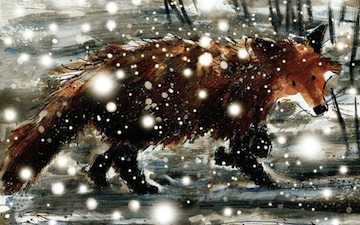The Red Fox (Vulpes vulpes) is the largest of the true foxes, as well as being the most geographically spread member of the Carnivora, being distributed across the entire northern hemisphere from the Arctic Circle to North Africa, Central America, and the steppes of Asia. Its range has increased alongside human expansion, having been introduced to Australasia, where it is considered harmful to native mammal and bird populations. Because of these factors, it is listed as Least Concern for extinction by the IUCN.[1]
The red fox is typically active at dusk (crepuscular) or at night (nocturnal), but is often active in the day in more undisturbed areas. The diet is extremely broad, and includes small mammals, manyinvertebrates, and birds, as well as fruit, carrion and items scavenged from dustbins, bird tables and compost heaps.
Red foxes prefer to hunt in the early morning hours before sunrise and late evening.[89] When hunting mouse-like prey, they first pinpoint their prey’s location by sound, then leap, sailing high above their quarry, steering in mid-air with their tails, before landing on target up to five metres away.[60]
Apart from its large size, the red fox is distinguished from other fox species by its ability to adapt quickly to new environments and, unlike most of its cousins, is not listed as endangered anywhere. Despite its name, the species often produces individuals with abnormal colourings, including albinos and melanists.[6]45 subspecies are currently recognised,[7] which are divided into two categories: the large northern foxes, and the small, primitive southern foxes of Asia and the Middle East.[8]
(From Wikipedia and EOL, 2 May 2011)




